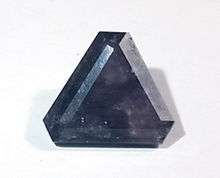Chambersite
| Chambersite | |
|---|---|
|
Chambersite from Barber's Hill Salt Dome, Mont Belvieu, Texas USA, the type locality. Size: 0.7 x 0.6 x 0.6 cm. | |
| General | |
| Category | Tektoborates |
| Formula (repeating unit) | Mn3B7O13Cl |
| Strunz classification | 06.GA.05 |
| Crystal system | Orthorhombic |
| Space group | Orthorhombic mm2 pyramidal |
| Unit cell | a = 8.68(1) Å, b = 8.68(1) Å, c = 12.26(1) Å; Z = 4 |
| Identification | |
| Color | Colorless to deep purple |
| Crystal habit | Pseudocubic crystals |
| Twinning | Rare as interpenetration twins on [111] |
| Cleavage | None |
| Fracture | Subconchoidal to uneven |
| Mohs scale hardness | 7 |
| Luster | Vitreous |
| Diaphaneity | Transparent to opaque |
| Specific gravity | 3.49 |
| Optical properties | Biaxial (+) |
| Refractive index | nα = 1.732 nβ = 1.737 nγ = 1.744 |
| Birefringence | δ = 0.012 |
| 2V angle | Measured: 83° |
| Dispersion | r > v |
| Alters to | Color darkens when exposed to sunlight |
| References | [1][2] |
Chambersite is a manganese borate mineral with formula: Mn3B7O13Cl. It is a member of the borate mineral series[3] that includes other minerals such as ericacite, Fe3B7O13Cl, and boracite Mg3B7O13Cl.[4] When chambersite was first discovered, it was the second chemical analogue of boracite to be found in nature.[5] It was discovered as a mineral at Barber's Hill salt dome in Texas in 1957 and in 1971 at the Dongshuichang deposit in Jixian, Tianjin, China.[6] Chambersite occurs associated with the evaporite minerals halite, anhydrite, and gypsum.[5]
Chemical and physical properties
When chambersite was first discovered in Barber's Hill, the dominate form was the positive tetrahedron, but single morphological twinned crystal was found with interpenetrating tetrahedrons with the twinning axis.[5] The ore discovered in China had formed in high grades that are spindle and granular that form micritic aggregates because the boron present is very pure and in low grades that had formed spheroids that are radially oriented.[6] When chambersite in China was compared it had the same chemical oxide ratio as the samples found in Barber's Hill.[6]
| Oxide | Chemical composition of chambersite in oxide percent[5] |
|---|---|
| B2O3 | 49.50 |
| MnO | 41.87 |
| Cl | 6.34 |
| FeO | 1.28 |
| MgO | 0.05 |
| CaO | trace |
| Total % | 99.04 |
Geologic occurrence
Chambersite minerals were first found in 1957 in brine returns from a gas storage well in the Barber's Hill salt dome and the age of the dome is not definitely known, but it is at least Cretaceous and probably upper Jurassic.[5] Other chambersite deposits with this similar geologic occurrence can be found in the area of the Gulf Coast of Mexico.[7] The Venice dome in Plaquemines Parish, Louisiana is a site that has a shallow piercement salt dome, LPG storage and brine production.[7] Other chambersite deposits can be found in the Penobsquis deposit in Southern New Brunswick, Canada, which has high grade salt deposits as well as a significant borate mineral concentration, including chambersite.[3] Other chambersite deposits can be found as ores in Ji County, Tianjin, China, an area that is considered to have had much magnetic activity and submarine volcanism in a subtidal lagoon.[6]
Special characteristics

Chambersite was named after the county where it was first discovered, Chambers County, Texas, US.[5] Optical examination and x-ray powder diffraction indicated the mineral to be related to boracite but different from any other published description.[5]
See also
References
- Anthony, J.W., Bidideaux, R., Bladh, K. and Nicholas, M. (2003) Chambersite Mn3B7O13Cl. Handbook of Mineralogy. Mineral data publishing
- Fan, DL, Yang, PJ, and Wang, R (1999) Characteristics and origin of the Middle Proterozoic Dongshuichang chambersite deposit, Jixan, Tixian, Tianjin, China. Ore Geology Reviews, 15, 15-29.]
- Grice, J. D., Gault, R. A., van Velthuizen, J. (2005) Borate minerals of the Penobsquis and Millstream deposit, southern New Brunswick, Canada. Canadian Mineralogist, 43, 1469-1488.]
- Honea, Russell M., Beck, Frank R. (1962) Chamersite, a new mineral. American Mineralogist, 47, 665-671.
- Smith, Arthur E., Jr. (1994) Louisiana mineral locality index. Rock and Mineral, 69, 156-162.]
- Yawn, B., Simmons, W. B., Falster, A. U. (1997) Chemical Zonation in Chambersite and Boraciate from salt domes in the Gulf Coast region. Rock and Minerals, 72, 192.
| Wikimedia Commons has media related to Chambersite. |
